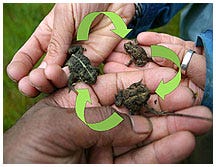By Jordan Schaul | National Geographic | October 8, 2012
Contributing Editor Jordan Schaul interviews Denver Zoo’s Director of Communications Tiffany Barnhart about some of the “greenest” achievements of any zoological park in North America.
Jordan: The Denver Zoo is the first AZA institution to have received certification, indicating the facility meets environmental management standards set by the International Organization for Standardization (ISO).
Congratulations on this great accomplishment. The Zoo clearly has made great strides to improve the efficiency and effectiveness of company operations. Can you elaborate more on what this certification means for your institution?
Tiffany: Thanks! This certification is very important for us. Our Sustainable Management System (SMS) was certified by the International Organization for Standardization. The SMS provides a systematic framework to help us evaluate our operations and develop strategies that take a holistic approach to reduce our impacts on the environment. It also provides tools to successfully imbed aspects of sustainable operations into our culture, by setting a clear direction for the organization and defining our individual roles and responsibilities. Our sustainable management system provides a place for employees to engage in the process and take action in their daily job functions to improve upon our efforts.
It also ensures that we are measuring our tactics, revealing both achievements and targets for improvement. Finally, it helps us be very accurate in how we communicate our successes and areas for improvement – we want to avoid greenwashing. We know we aren’t perfect and this framework outlines how we address findings when we are falling short of our goals for sustainability.
The certification itself is very beneficial because it provides credibility giving us leverage when we speak with outside audiences and our generous donors and partners. The certification has also provided a way for our executive leaders to speak to our board and drive the commitment through overall site policy and direction setting.
Jordan: The Zoo also demonstrates its commitment to environmental stewardship by appointing a staff member to the role of Sustainability Coordinator. Essentially, this person oversees and advises the organization’s green team. Please tell us a bit about the composition of the green team and more specifically what the role of the Sustainability Coordinator is for the organization?
Tiffany: Sustainability is of paramount importance to us at Denver Zoo and recently we promoted our Sustainability Coordinator to Sustainability Manager – both to recognize the importance of the position and the responsibility this position manages. This position was new at Denver Zoo in 2009. Before formalizing this position, we were lucky to have an engaged and involved green team that started our green initiatives on-site as a grassroots effort. This green team drove the initial framework that we value today that is based on metrics and monitoring of our operations to better guide our improvements. Based on the results of the initial green team, Denver Zoo executives saw the importance of incorporating sustainability more intently into our organizational structure. With the commitment to move toward ISO and the growth of a formalized program, we needed a dedicated position to lead these efforts. Through our commitments from the green team lead by our Sustainability Manager, Denver Zoo is now seen as a leader in the zoo and aquarium world. With members representing every department in the zoo, the functions of our SMS are truly driven into our operations.
Jordan: The Colorado Department of Public Health and Environment awarded the Zoo its Sustainability Champion Team Award for 2010. Congratulations again! Were there specific contributions that the Zoo made to sustainability or was it a collective effort and an array of green accomplishments that you suspect put you in first place among the competition?
Tiffany: I believe it was our collective efforts and a strong commitment to continual improvement that made us the ideal award recipient. I also think that our waste-to-energy system (poop to power!) and the fact that our overall program has grown beyond the concepts of recycling to more operational efficiencies has helped garner attention from outside organizations. For instance, instead of having one-off recycling efforts, we looked at waste as a resource for renewable clean energy development on site. It’s taking simple ideas and using innovation to holistically address several sustainable goals.
Jordan: Can you highlight some of your green initiatives over the past decade. What are you most proud of and what might the Zoo staff be most proud of in terms of specific accomplishments?
Tiffany: It’s hard to pick one area as we have been effective in improvements in many areas including water use reduction, energy use, alternative transportation use among employees, green building strategies, and our strides to become a zero-waste facility. So to me, what’s remarkable is what enabled all these improvements to happen – our staff engagement. We have created a new culture that values sustainability and innovation. This has been key to our successes and is critical to our future progress.
Jordan: Jennifer Hale is the Chair of the AZA Scientific Advisory Group for green initiatives or the Green Advisory Group—another great accomplishment for your zoo. Does this mean that the Zoo will have some influence over helping other institutions meet their potential for contributing to the green movement and mitigating their respective environmental impacts?
Tiffany: Absolutely. Jennifer has taken a leadership role helping guide other zoos and aquariums in the development of programs that fit their needs. Her common-sense approach encourages measurement to build a baseline for goal setting. With support from the Green Advisory Group, Jennifer has helped other zoos and aquariums realize the savings they can accomplish through sustainable action – like saving money on energy bills. This helps provide support to individuals at other zoos that may not have strong management support for their programs.
Jennifer’s work on the SAG has also been beneficial to Denver Zoo. Having a group of individuals dedicated to sustainability has provided a valuable network. Together this group has achieved much in the advancement in sustainability amongst accredited zoos and aquariums.
Jordan: What are some future goals and objectives for the Denver Zoo’s Green Team?
Tiffany: In the future, you will see Denver Zoo growing our program and becoming more innovative. We have begun thinking about the bigger picture of sustainability. We are looking at solutions that not only address environmental impacts but also social and economic factors related to limiting our use of resources. Out of one of our initiatives to become a zero-waste facility, for instance, we have begun creating a purchasing policy and software program to ensure the products we buy, meet our expectations for environmental and social responsibility. As we begin to plan for the future of our zoo through our master planning efforts, I expect to see us incorporate concepts for the design and construction of a zoo that works with its environment. We are also very proud of our accomplishments and are relentless in our pursuit to be a leader in sustainability. We must serve as a strong example to encourage others to make positive changes.
DENVER ZOO QUOTE: “As an organization dedicated to wildlife conservation, Denver Zoo is trying to be as environmentally conscious as possible, in every facet of our organization. We’re encouraging others to do the same. It’s amazing how small changes can result in tremendous positive impact, especially when many people practice them over time.”
—Denver Zoo President/CEO Craig Piper
ABOUT NATIONAL GEOGRAPHIC SOCIETY
The National Geographic Society is a global nonprofit organization that uses the power of science, exploration, education and storytelling to illuminate and protect the wonder of our world. Since 1888, National Geographic has pushed the boundaries of exploration, investing in bold people and transformative ideas, providing more than 14,000 grants for work across all seven continents, reaching 3 million students each year through education offerings, and engaging audiences around the globe through signature experiences, stories and content. To learn more, visit www.nationalgeographic.org or follow us on Instagram, Twitter and Facebook.
MEET THE AUTHOR
Jordan Carlton SchaulWith training in wildlife ecology, conservation medicine, and comparative psychology, Dr. Schaul's contributions to Nat Geo Voices have covered a range of environmental and social topics. He draws particular attention to the plight of imperiled species highlighting issues at the juncture or nexus of sorta situ wildlife conservation and applied animal welfare. Sorta situ conservation practices are comprised of scientific management and stewardship of animal populations ex situ (in captivity / 'in human care') and in situ (free-ranging / 'in nature'). He also has a background in behavior management and training of companion animals and captive wildlife, as well as conservation marketing and digital publicity. Jordan has shared interviews with colleagues and public figures, as well as editorial news content. In addition, he has posted narratives describing his own work, which include the following examples: • Restoration of wood bison to the Interior of Alaska (As Animal Curator at Alaska Wildlife Conservation Center and courtesy professor at the University of Alaska) • Rehabilitation of orphaned sloth bears exploited for tourists in South Asia (As executive consultant 'in-residence' at the Agra Bear Rescue Center managed by Wildlife SOS) • Censusing small wild cat (e.g. ocelot and margay) populations in the montane cloud forests of Costa Rica for popular publications with 'The Cat Whisperer' Mieshelle Nagelschneider • Evaluating the impact of ecotourism on marine mammal population stability and welfare off the coast of Mexico's Sea of Cortez (With Boston University's marine science program) Jordan was a director on boards of non-profit wildlife conservation organizations serving nations in Africa, North and South America and Southeast Asia. He is also a consultant to a human-wildlife conflict mitigation organization in the Pacific Northwest. Following animal curatorships in Alaska and California, he served as a charter board member of a zoo advocacy and outreach organization and later as its executive director. Jordan was a member of the Communication and Education Commission of the International Union for the Conservation of Nature (CEC-IUCN) and the Bear Specialist Group of the IUCN Species Survival Commission (BSG-SSC-IUCN). He has served on the advisory council of the National Wildlife Humane Society and in service to the Bear Taxon Advisory Group of the Association of Zoos and Aquariums (AZA Bear TAG). In addition, he was an ex officio member of the council of the International Association for Bear Research and Management.



